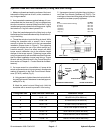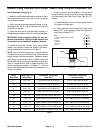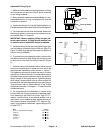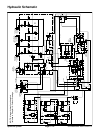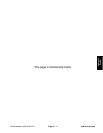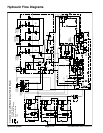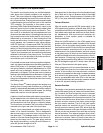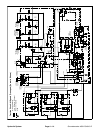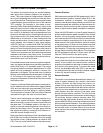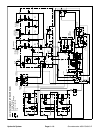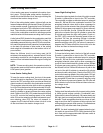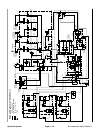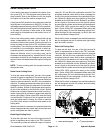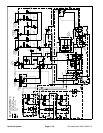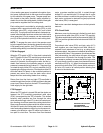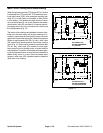
Groundsmaster 4000--D/4010--D Hydraulic SystemPage 4 -- 15
Traction Circuit: HI Speed (Transport)
The traction circuit piston pump is a variable displace-
ment pump that is directly coupled to the engine fly-
wheel. This pump utilizes an integral electro--hydraulic
servo piston assembly that controls the rate and direc-
tion of hydraulic flow.Pressing the traction pedalrotates
a potentiometer that provides an input to the machine
TEC controller. The controller in turn sends a corre-
sponding PWM (Pulse Width Modulation) output to the
electronic pump control to rotate the pump swash plate
accordingly to control pump output and direction. Trac-
tion circuit oil is directed to the dual displacement front
wheel and rear axle motors. Operating pressure on the
high pressure side of the closed traction circuit loop is
determined by the amount of load developed at the
wheel and axle motors. As the traction load increases,
circuit pressure can increase to relief valve settings:
4350 PSI (300 bar) in forward and 5000 PSI (345 bar)
in reverse. If traction circuit pressure exceeds the relief
setting, oil flows through the piston pump relief valve to
the low pressure side of the closed loop traction circuit.
Traction circuit pressure can be measured at test ports
attached to the sides of the piston pump. The forward
traction port is on the right side of the pump and the re-
verse traction port is on the left side.
Front wheel and rear axle motors are positive displace-
ment, two speed variable motors that allow operation in
either LOW (mow) or HI (transport) speed. The motors
are spring biased to maximum displacement for LOW
speed and are h ydraulically shifted to minimum dis-
placement for HI speed. The rear axle motor includes a
flushingvalvethatbleeds offa smallamountof hydraulic
oil for cooling of the closed loop traction circuit. The
charge circuit replaces oil that is bled from the circuit by
theflushingvalve.
Atraction circuit flowdivider splitst raction pumphydrau-
lic flow between the front wheel motors (approximately
45%) and rear axle motor (approximately 55%) to pre-
vent excessive circuit flow going to a spinning wheel.
The flow d ivider is located in the front traction manifold
mounted to the right, rear side of the front frame.
Traction circuit components use s mall amounts of hy-
draulic oil for internal lubrication. Fluid is designed to
leak across traction pump and motor components into
the case drain. This leakage results in the loss of hy-
draulic oil from the closed loop traction circuit that is re-
placed by the charge circuit. The gear pump sections
that supply the steering, cooling fan and lift/lower cir-
cuits also provide charge circuit oil.
Gear pump flow forthe chargecircuit is directedthrough
the oil filter and to the low pressure side of the closed
loop traction circuit. Charge pressure is limited to 250
PSI (17 bar) by a relief valve located in the piston pump.
Forward Direction
WiththearmrestconsoleHI/LOWspeedswitchintheHI
speed (transport) position, solenoid valve (S12) in the
combination manifold is energized. The energized
solenoid valve directs charge pressure to shift the front
wheel motors and rear axle motor to their minimum dis-
placement. With the motors at their minimum displace-
ments, a higher traction speed is available for transport.
When the HI/LOW switch is in the HI speed (transport)
position and the traction pedal is pushed in the forward
direction, oil from the piston pump passes through the
front tractionmanifold.Oil flowfor thefront wheelmotors
leaves front traction manifold port M1 to drive the front
wheel motors in the forward direction and then returns
to the piston pump. Oil flow from front traction manifold
port M2 is directed to drive the rear axle motor in the for-
ward direction. Oil returning from the axle motor enters
the rear traction manifold at the M8 port. Flow bypasses
the PR cartridge through the CV check valve, out man-
ifold port P2 and returns to the piston pump.
When going down a hill, the tractor becomes an over--
running load that drives the f ront wheel and rear axle
motors. In this condition, the rear axle motor could lock
up as the oil pumped from the motor increasespressure
as it returns to the piston pump. To prevent rear wheel
lock up, an adjustable relief valve (RV) in the rear trac-
tion manifold reduces rear axle motor pressure created
in down hill, dynamic braking conditions.
Reverse Direction
The traction circuit operates essentially the same in re-
verse HI speed (transport) as it does in the forward
direction. However, the flow through the circuit is re-
versed. Oil flow from the piston pump is directed to the
frontwheel motors andalsoto therear tractionmanifold.
The oil to the front wheel motors drives them in the re-
verse direction and then returns to the piston pump
through the front traction manifold. The oil to the rear
traction manifoldenters thereartraction manifoldat port
P2 and flows through pressure reducing valve (PR)
which limits the down stream pressure to the rear axle
motorto380 PSI(26 bar)so therear wheelswill notscuff
the turf duringreverse operation.This reducedpressure
flowis directedout reartractionmanifold port M8todrive
the rear axle motor in reverse. Return oil from the rear
motor returns to the piston pump through the front trac-
tion manifold.
Hydraulic
System



